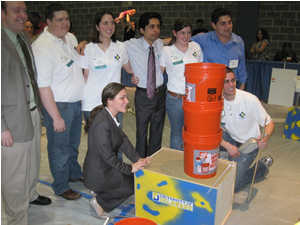The Geo-Institute of ASCE held its annual event in West Palm Beach, Florida 20-24 February 2010. And I am very pleased to report that the event was vibrant with a broad range of activity and healthy level of attendance.
One of the remarkable characteristics of this event was the diversity of both attendee specializations and subject matters covered. Every facet of industry and academia seemed to be represented by the 850+ attendees. The 3.5-day technical program was so completely full that at times it was difficult for attendees to choose which of the sessions to attend. In fact when I asked Conference Chair Prof. Patrick Fox, University of California San Diego what he felt was the biggest success of the conference he cited the excellent depth and breadth of the technical and social programs.
This is particularly important to note as many conferences have been forced to reduce their offerings as a result of the struggling economy and poor attendance.
Not to be forgotten, the Exhibit hall was at capacity with 82 Exhibitors. Manufacturers spoke with attendees during an opening night cocktail reception. Mike Clements from Huesker commented, “We have cut down on the number of shows we are doing but I knew this was one we had to be at!”
Geosynthetics were well represented in technical sessions, on the exhibit floor and very notably as the subject of the Prestigious Terzaghi Lecture which was awarded this year to Dr. Robert Holtz. Dr. Holtz presented Reinforced Soil Technology: From Experimental to the Familiar. The lecture took us through the history of soil reinforcement and offered some interesting photos from the very early days of geosynthetic soil reinforcement. Dr. Holtz shared with us his lessons of what to do and what not to do. He emphasized the three most important considerations in soil reinforcement design: drainage, drainage and drainage!
He compelled engineers to work more closely with the K-Stiffness method and provide feedback. And he showed some amazing photos of geosynthetic reinforcement success stories from around the world.
But the most compelling portion of the lecture (from this audience member’s perspective) was the 7th segment in which Dr. Holtz posed some Technical and Professional questions. He encouraged academics and engineers alike to address the need for a better understanding of seismic design behavior and the need for a “poor man’s plane/strain” testing device. Citing a conversation with Dr. Robert Koerner, Dr. Holtz contrasted the methods of teaching “wall design” and “steep slope reinforcement.” He asked everyone to consider why these two practices are presented in such technically different ways–after all, isn’t a wall just a very steep, reinforced slope? And, at least as it pertains to North America, Dr. Holtz acknowledged the jurisdictional dysfunction of our regulatory system and challenged the audience to find resolution.
STUDENT COMPETITION
The student population was very well represented. With approximately 170+ students attending Geo-Florida there was no shortage of fresh enthusiasm. There were multiple student-related activities but of course the most exciting was the Student GeoWall Competition. A number of experienced student teams entered but the first-time entrant from the University of Delaware took 1st place. The competition challenges teams to design a reinforcement system using the least amount of paper. The system is created in a wooden box and filled with silica sand. Each team has a limited amount of time in which to build their wall. Once the wall has been built the single side of the box covering the face of the wall is removed. Using a stick to ensure the face of the wall remains behind the face of the box, Judges confirm that walls have not deformed to the point of a technical failure. Once the initial time criterion has been met, teams place a load on and behind the wall by adding a pail and 50lbs of sand, this is done in intervals until 3 pails and a load of 150lbs. has been achieved.
Some photographs from the competition:
 |
 |
 |
The student completion is sponsored by Tencate Geosynthetics North America (Pendergrass, GA) and HUESKER, Inc. (Charlotte, NC) among others.
LOOKING AHEAD:
GEO-FRONTIERS 2011
Sometimes stand-alone events and sometimes paired with another organization the Geo-Institute events are also diverse in their formatting and presentation. In 2011 this event will return to a Geo-Frontiers format. Geo-Frontiers has been held only once before–in 2005 in Austin, TX (view conference report)–and has since been revered as one of the single most successful Geosynthetics-related events in the history of our industry. The event combines participants and organizers from all of the aspects of geosynthetics industry. Specifically The North American Geosynthetics Society (NAGS) brings geosynthetics specialists both from academia and industry, the Geo-Institute of ASCE brings practitioners who make up 80% of the Geo-Institute’s membership, and the Geosynthetics Research Institute (GRI) and the Geosynthetics Materials Association (GMA) bring manufacturers and other industry professionals.
We look forward to seeing what Geo-Frontiers 2011 will provide as it combines complete representation of our industry and the industries we touch!
Elizabeth Peggs is the Director of Geosynthetica. Contact Us Today.












